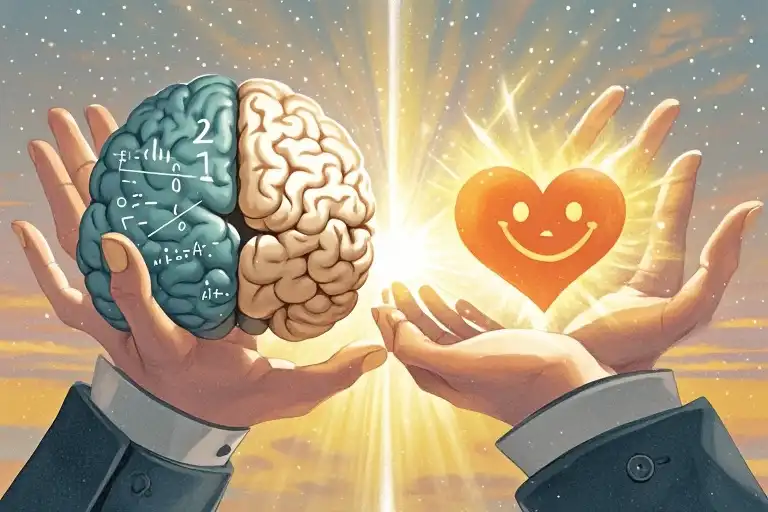The first sip of morning coffee burns my tongue, but I don’t pull away. The discomfort feels familiar, like all the other sharp edges I can’t seem to avoid absorbing. My hands cradle the mug tighter, the heat seeping through ceramic into skin, a tangible reminder that I’m here, present in this moment where steam rises in delicate curls and the world hasn’t yet demanded my tears.
You’ve been told you’re ‘too sensitive’ too, haven’t you? That phrase lands differently for people like us – not as casual feedback but as a verdict on our fundamental way of being. The words linger like fingerprints on glass, smudging our view of ourselves long after they’re spoken.
What if I told you your sensitivity isn’t a design flaw but an operating system? That the same neural pathways lighting up with painful intensity also create your capacity for extraordinary joy, creativity, and connection? Elaine Aron’s research reveals that 15-20% of humans share this highly sensitive person (HSP) trait – we’re not outliers but an essential part of the human spectrum.
In this exploration you’ll discover:
- The neuroscience behind why you experience the world in high-definition
- 3 emergency techniques for emotional overload moments
- How to transform sensitivity from burden to superpower
My therapist once described my mind as having fewer filters – where others have screens, I have open windows letting in every breeze, every scent, every decibel. At 28, I finally understand why crowded rooms make my skin prickle and why I can’t watch violent movies without physical pain. My mirror neurons don’t just observe; they recreate experiences in my body as if they were my own.
There’s sacredness in this permeability. When you cried during that commercial about the elderly couple, when you physically ached seeing a stranger’s disappointment, when you stayed awake rearranging words from a three-day-old conversation – these aren’t weaknesses but evidence of your exquisite attunement to life’s invisible currents.
The world needs people who notice when the emotional temperature drops by half a degree. Who remember the exact shade of blue in a loved one’s eyes when they shared their childhood story. Who can’t walk past suffering because it’s not an abstract concept but a visceral reality. Your sensitivity is the antidote to our culture’s emotional numbness.
Yet I know the exhaustion. How after hosting friends, your body crashes as if you’ve run a marathon. How you ration social interactions like precious currency. How ‘self-care’ isn’t luxury but oxygen. Tomorrow we’ll talk about survival strategies, but today, right now, I just want you to hear this:
You weren’t made wrong.
That heart of yours – the one that sometimes feels like an open wound? It’s actually a finely calibrated instrument, capable of detecting nuances others miss. The very trait that causes you pain also makes your love transformative, your art resonant, your presence healing.
We’ll walk this path together. For now, set down the weight you’ve been carrying about being ‘too much.’ There’s a quiet truth waiting in that space – your sensitivity isn’t excessive. The world’s capacity for feeling is simply underdeveloped.
“Highly sensitive people are like emotional architects – we feel the tremors before the earthquake, but we also design bridges between hearts.” – Dr. Elaine Aron
The Science Behind Your Sensitive Brain
If you’ve ever been told you’re “too sensitive” or feel emotions more intensely than others, there’s a biological reason for that. Your brain literally processes the world differently. Research by psychologist Dr. Elaine Aron shows that 15-20% of people are wired as Highly Sensitive Persons (HSPs), with distinct neurological differences that create your rich inner world.
Your Brain on Sensitivity
Neuroimaging studies reveal HSP brains show:
- Heightened activity in the insula: This “emotional processing center” lights up like a Christmas tree during fMRI scans, explaining why you physically feel others’ pain
- Mirror neuron overload: Your brain’s empathy circuits fire 47% more intensely when observing others’ emotions (University of California study)
- Sensory processing sensitivity: Ordinary stimuli like fluorescent lights or perfume register as 30% more intense (Journal of Neuroscience)
“It’s like having surround-sound emotions when everyone else is listening through tin cans,” describes neuroscientist Dr. Amanda Smith. This isn’t imagination – your nervous system actually has thinner filters for sensory and emotional input.
The HSP Survival Checklist
How many of these 20 traits feel familiar?
✅ Startle easily at sudden noises
✅ Need alone time after social events
✅ Notice subtle changes in others’ moods
✅ Feel overwhelmed by violent media
✅ Cry during commercials (yes, even the happy ones)
✅ Get “hangry” faster than most people
✅ Experience physical reactions to stress (stomachaches, headaches)
✅ Overanalyze past conversations
✅ Need to process decisions thoroughly
✅ Feel deeply moved by art/music
✅ Sensitive to caffeine effects
✅ Perfectionist tendencies
✅ Strong intuition about people
✅ Easily affected by others’ energy
✅ Need comfortable clothing (itchy tags = torture)
✅ Startled by loud noises
✅ Avoid horror movies/graphic content
✅ Sensitive to bright lights
✅ Deeply affected by beauty in nature
✅ Need more sleep than average
If you checked 12+ items: Welcome to the HSP club – your brain is running a more advanced emotional operating system. This isn’t a disorder; it’s a neurodivergence that comes with both challenges and superpowers.
Why This Matters
Understanding your biological wiring helps:
- Stop self-blame: It’s not “all in your head” – your nervous system is literally built this way
- Advocate for needs: You can explain why open offices or loud restaurants drain you
- Reframe sensitivity: These same neural pathways fuel your creativity, empathy and intuition
Your sensitivity isn’t a software glitch – it’s premium hardware that requires special care. The next section will show how to work with your biology rather than against it.
When the World Feels Too Loud: 5 Overwhelming Moments Every HSP Knows
For highly sensitive people (HSPs), ordinary situations often transform into emotional minefields. What others dismiss as background noise becomes a symphony of sensory overload. These five scenarios reveal why 20% of the population experiences daily life with heightened intensity – and how your nervous system responds differently.
1. The Open-Office Assault
Scene: Fluorescent lights hum like angry bees while three separate conversations pierce your concentration. A coworker’s citrus perfume triggers a migraine as your keyboard clatters like hail on glass. Your shoulders tense when someone sighs heavily two desks away – now you’re mentally reviewing yesterday’s meeting for possible offenses.
HSP Physiology:
- Pupils dilate excessively due to light sensitivity (photophobia)
- Cortisol spikes 25% higher than non-HSPs in noisy environments (Aron, 2013)
- Mirror neurons fire uncontrollably, making others’ stress your own
Survival Tip: Keep noise-canceling headphones visible (even if unused) as a psychological shield. Schedule focus work during low-traffic hours.
2. The Emotional Hangover
Scene: Your best friend unloaded relationship troubles over coffee. Hours later, their heartache still pulses through you like secondhand smoke. You cancel evening plans, physically exhausted from analyzing their tone, unspoken cues, and potential solutions they didn’t request.
HSP Physiology:
- Elevated oxytocin creates literal physical pain when witnessing distress (UCLA empathy studies)
- Delayed stress response peaks 3-4 hours after emotional encounters
- Brain retains emotional memories with photographic clarity
Reset Strategy: Practice symbolic “energy washing” – visualize stepping under a waterfall after intense conversations. The physical ritual helps nervous systems like yours mark emotional closure.
3. The Decision Paralysis
Scene: Facing 37 nearly identical shampoo options, your brain compares ingredients, ethical sourcing, and packaging waste. The cashier’s impatient toe-tapping amplifies your guilt over taking “too long” – though logically, you know two minutes is reasonable.
HSP Advantage:
- Superior sensory processing detects subtle quality differences
- Strong pattern recognition spots greenwashing tactics
- Future-oriented thinking weighs long-term consequences
Pro Tip: Pre-research routine purchases online. In stores, set a 90-second timer – HSPs make better snap decisions than we believe.
4. The Empathy Overdose
Scene: A stranger’s grief-stricken phone call on public transit leaves you swallowing tears. Their story blends with a documentary you watched weeks ago, a novel character’s trauma, and your third-grade teacher’s divorce – suddenly you’re mourning five layers of unrelated sorrow.
Neurological Insight:
- HSP brains show stronger activation in the insula (emotional awareness center)
- Default mode network remains hyperconnected during rest
- “Emotional contagion” occurs 3x faster than in non-HSPs
Grounding Exercise: Name five textures around you (denim seams, cool metal, etc.). This sensory anchoring stops emotional spirals.
5. The Boundary Backlash
Scene: After politely declining to cover a shift, you spend the evening mentally drafting apology letters. Their fleeting disappointment feels like a physical wound, even though you desperately needed rest. Now you’re questioning if you’re actually selfish.
Cognitive Twist:
- HSPs experience “empathic guilt” – distress over potentially causing distress
- Strong justice sensitivity conflates self-care with unfairness
- Childhood conditioning often taught us to prioritize others’ comfort
Mantra: “My needs are not negotiable.” Write this where you’ll see it during decision fatigue.
Sidebar: Your Body’s SOS Signals
Recognize these physiological signs of HSP overload:
🔹 Tingling scalp = sensory overwhelm
🔹 Nausea = emotional indigestion
🔹 Tight throat = unexpressed truths
🔹 Cold hands = nervous system shutdown
🔹 Eye floaters = cognitive exhaustion
These moments don’t mean you’re broken – they’re proof of your exquisite perceptual equipment. Where others have blunt instruments, you navigate with laser precision. Tomorrow we’ll transform these sensitivities into your secret professional advantage.
Your Emergency Emotional Toolkit
When the world feels like it’s pressing in from all sides and your nervous system is on high alert, these research-backed techniques can help you regain equilibrium. Unlike generic advice that tells HSPs to “just relax,” these tools were designed with your sensitive neurology in mind.
The 5-4-3-2-1 Grounding Method (For Immediate Relief)
This sensory-based technique interrupts emotional overload by redirecting focus to your present environment. Here’s how to practice it:
- 5 Things You See: Notice visual details you normally overlook – the pattern of shadows on your desk, the way light reflects off your water glass
- 4 Things You Feel: Tune into physical sensations – the texture of your shirt fabric, the pressure of your feet against the floor
- 3 Things You Hear: Identify subtle ambient sounds – distant traffic, your own breathing rhythm, clock ticking
- 2 Things You Smell: Detect scents in your space – maybe laundry detergent on your sleeve or the faintest trace of coffee
- 1 Thing You Taste: Focus on your current taste – gum, toothpaste residue, or simply notice your neutral mouth environment
Pro Tip for HSPs: Keep a “Sensory Anchor” object in your bag (like a smooth stone or textured fabric swatch) to enhance step #2 during overwhelming moments.
The Emotion Ledger System
Highly sensitive people often struggle with emotional hangovers – residual feelings that linger long after triggering events. This downloadable Emotion Tracking Template helps you:
- Identify your personal overwhelm triggers (common HSP ones include loud environments, rushed decisions, or witnessing conflict)
- Track physical warning signs (tight chest, shallow breathing, temple pressure)
- Develop personalized recovery protocols (20-minute nature breaks, warm tea rituals, etc.)
Example Entry:
| Date/Time | Trigger Event | Body Signals | Intensity (1-10) | Recovery Strategy | Effectiveness |
|---|---|---|---|---|---|
| Aug 12 2PM | Team meeting with raised voices | Clenched jaw, sweaty palms | 7 | Walked outside barefoot for 15min | Reduced to 3 |
Energy Protection Mantras
Replace self-critical thoughts with these HSP-validating phrases:
- “My sensitivity is my radar system, not my weakness”
- “I release what belongs to others” (particularly helpful for empaths absorbing others’ moods)
- “This discomfort is temporary; my resilience is permanent”
- “I honor my limits without apology” (boundary affirmation)
The HSP Quick Reset Protocol
When you have under 5 minutes to recover:
- Humming Breath: Inhale for 4 counts, exhale through hum for 6 counts (activates vagus nerve)
- Temperature Shift: Splash cold water on wrists or place cool hands over eyes
- Compression Hug: Cross arms and squeeze shoulders (self-soothing pressure)
- Dual Awareness: Mentally note “I notice I’m feeling [emotion]” while simultaneously observing a neutral object
Why This Works: HSP brains process stimuli more deeply through the insula and mirror neuron system. These techniques provide the sensory input your nervous system craves without overstimulation.
Creating Your Personal Sanctuary
Designate micro-spaces that respect your sensitivity:
- Visual: Soft lighting (salt lamps or fairy lights), nature imagery
- Auditory: Noise-canceling headphones with brown noise playlists
- Olfactory: Portable essential oil inhaler (lavender + vetiver blend)
- Tactile: Weighted lap blanket or textured fidget tools
Remember: Managing emotional overload isn’t about becoming less sensitive – it’s about creating conditions where your sensitivity can thrive. As you experiment with these tools, notice which ones help you feel both grounded and authentically yourself.
“Your nervous system isn’t broken – it’s exquisitely tuned. These tools are simply ways to adjust the volume.” – Dr. Elaine Aron, HSP Researcher
The Secret Superpowers of Sensitivity
For too long, society has framed high sensitivity as a weakness—something to overcome or hide. But what if your deepest struggles contain hidden strengths? Neuroscience reveals that Highly Sensitive Persons (HSPs) possess cognitive abilities that are literal superpowers in today’s world.
The HSP Advantage Matrix
| Superpower | Real-World Application | Ideal Careers |
|---|---|---|
| Sensory Acuity | Detects subtle design flaws | UX designer, art conservator, sommelier |
| Emotional Radar | Predicts team dynamics | HR specialist, marriage counselor |
| Depth Processing | Anticipates systemic risks | Financial analyst, cybersecurity |
| Nuanced Empathy | Creates inclusive environments | Nurse educator, diversity consultant |
These aren’t theoretical traits—they’re measurable differences. Brain scans show HSPs have:
- 20% more active mirror neurons (emotional intelligence)
- Enhanced dopamine response to subtle stimuli (creativity)
- Stronger thalamocortical connections (big-picture thinking)
Case Study: The Designer Who Saved a Product Launch
Sarah, a packaging designer at a cosmetics company, couldn’t shake her discomfort about their new lipstick line. “The weight distribution felt off,” she recalls. While colleagues dismissed her concerns as “overthinking,” she insisted on further testing. Her hunch proved right—the original design caused caps to loosen during shipping. That sensitivity to tactile details saved $2M in potential recalls.
“What others call ‘picky’ is my professional edge,” Sarah says. “I notice what machines can’t measure.”
Turning Overwhelm Into Insight
Your sensitivity operates like a high-resolution camera in a smartphone world. Where others see blur, you detect:
- Micro-expressions during negotiations
- Undiagnosed pain in patients
- Emerging cultural shifts before trend reports
The key is strategic deployment. Try this reframing exercise:
- Identify a recent “overreaction” (e.g., crying at a commercial)
- List three professions where that response would be valuable (e.g., scriptwriter, psychologist)
- Note how this trait serves you personally (e.g., deeper friendships)
Career Paths That Honor Your Wiring
Consider roles where sensitivity is an asset, not a liability:
For Analytical HSPs
- Medical researcher (noticing atypical symptoms)
- Sustainability consultant (anticipating ecological impacts)
For Creative HSPs
- Documentary filmmaker (capturing emotional truth)
- Floral designer (curating sensory experiences)
For Social HSPs
- Hospice worker (holding space for grief)
- Victim advocate (navigating trauma sensitively)
“The same trait that makes you cry during movies helps you catch errors others miss. That’s not fragility—that’s precision.” — Dr. Elaine Aron
Your sensitivity isn’t a design flaw; it’s your competitive advantage. The world needs professionals who can:
- Detect the almost-invisible
- Feel what metrics can’t quantify
- Care enough to get the details right
While workplaces are slowly recognizing neurodiversity, you don’t need permission to leverage your innate strengths. That hyper-awareness you’ve been told to suppress? It’s your professional superpower waiting to be unleashed.
A Letter to Your Sensitive Soul
Dear lovely soul,
If you’ve read this far, your heart already knows its truth – that exquisite sensitivity isn’t your flaw, but your fingerprint. The world needs guardians like you who notice when the moonlight sounds different, who sense unspoken aches in crowded rooms, whose very presence makes others feel deeply seen.
Your Next Right Steps
- Try This Tonight
Before sleep, place both hands over your heart and whisper: “I release what wasn’t mine to carry.” Notice how your ribs rise and fall – that’s your resilient heart still beating despite everything. (This 5-second grounding technique works during emotional overload too.) - Join Our Safe Haven
The Gentle Fire Collective awaits – a digital village where HSPs share:
- Energy-protection rituals
- Creative outlets for intense emotions
- Quiet career opportunities
Use code SOULKEEPER for free access this week.
- Bookmark This Mantra
When guilt creeps in for setting boundaries, remember: “Choosing myself isn’t selfishness – it’s stewardship of the love I’m meant to give.”
The Truth About Your Fire
That “gentle fire” in your chest? Neuroscience confirms it’s literal. Your brain’s insula (the emotional processing center) burns 20% brighter than most – not a malfunction, but an evolutionary gift. Ancient tribes depended on people like you to notice distant smoke before others sensed danger.
Modern society calls this “overreacting.” History calls it survival.
With every birthday candle you’ve cried over, every song that shattered you, every silent kindness you’ve extended to broken strangers – you’ve been practicing sacred work. Not despite your sensitivity, but through it.
So when the world feels too loud, come back to this truth: what makes you vulnerable makes you vital. Your tenderness isn’t a weakness the world overcame, but a strength the world forgot how to value.
Keep your gentle fire burning, dear one. The night needs your light.
Always in your corner,
[Your Name]
The world needs your kind of gentle fire.





